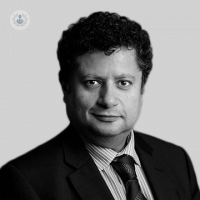How does awake brain surgery really work?
Written in association with:Awake brain surgery, or an awake craniotomy, is a surgical procedure carried out on the brain whilst the patient is awake and conscious. This procedure is used when surgery is being performed close to part of the brain that controls speech and motor functions. Professor Keyoumars Ashkan, a leading neurosurgeon at the London Neurosurgery Partnership, explains how awake brain surgery is performed, the risks involved and what the recovery period looks like following this complex and remarkable procedure.

Why must the patient remain awake?
It is really important that the patient is awake for such neurosurgical procedures because it allows the surgical team to check the patient’s function throughout the procedure. This may involve asking the patient questions during the procedure.
What are the risks of awake brain surgery?
As with any surgical procedure, an awake craniotomy carries risks which differ between patients. The following are some general risks associated with awake brain surgery:
- Brain swelling
- Speech or learning difficulty
- Impaired coordination and balance
- Infection
- Memory loss
- Visual changes
- Meningitis
- CSF (cerebrospinal fluid) leak
What happens during awake brain surgery?
Generally, an awake craniotomy will occur in the following steps:
- The patient is given some sedative drugs to ensure they feel relaxed and numbed in the incision site. The incision site is made using special equipment.
- Next, the patient’s head is fixed into a position that will ensure surgical accuracy, but also comfort for the patient. They should still be able to move their arms and legs for the duration of the operation.
- Medical drapes are then placed over the patient, but they will still be able to see and speak with the surgical team.
- In order to open the skull, the patient must be fully sedated. After this is done, sedation is stopped to ensure that they are awake throughout the rest of the procedure.
- With the help of advanced brain mapping technology, we are able to map out the important areas of the brain, including the speech, motor and sensory regions. This is achieved by using small electrical probes on the brain’s surface to map these regions. The aim is to ensure that they are avoided and preserved during surgery (these areas are consistently tested throughout the operation).
- After the tumour has been removed and the bleeding has stopped, sutures are used to close the dura. The scalp is then closed, using staples to close the skin of the incision site. Wound dressing is then applied.
How long will I have to stay in hospital and what does the recovery process look like?
The hospital stay will vary, but generally the patient can expect to stay at least a couple of days. The first is spent in the intensive treatment unit (ITU) so that the patient can be closely monitored, but the patient should be able to move as soon as possible, as well as eating and drinking normally. Before being discharged, the patient may have a post-operative scan to ensure everything is fine at the operation site.
Recovery takes a couple of weeks, during which time it is advised to take time off work. Patients can expect to experience some pain during this time, but this can be managed with painkillers prescribed on being discharged from hospital. During these two weeks getting plenty of rest is really important and the patient can expect to feel tired. A few weeks after surgery, the patient will have another post-operative scan to assess the operation site.
If you would like to book a consultation with Professor Keyoumars Ashkan, you can do so today via his Top Doctors profile.


